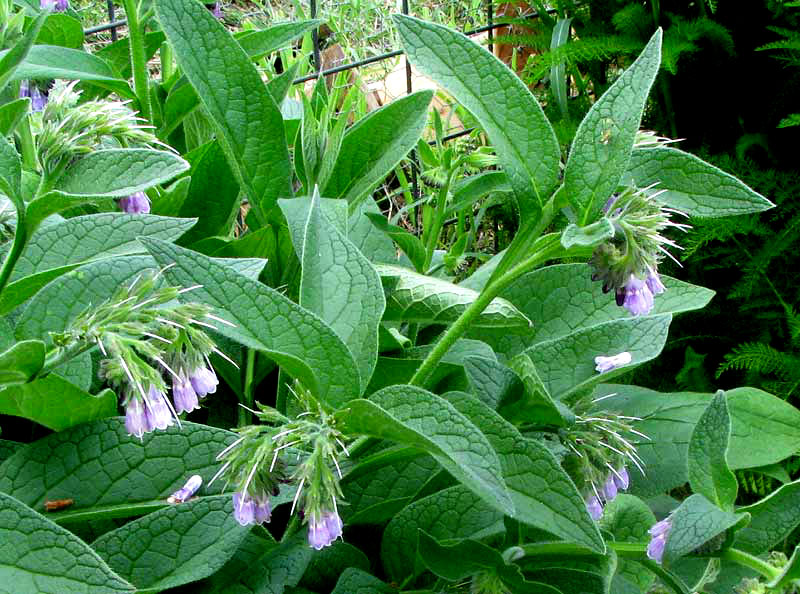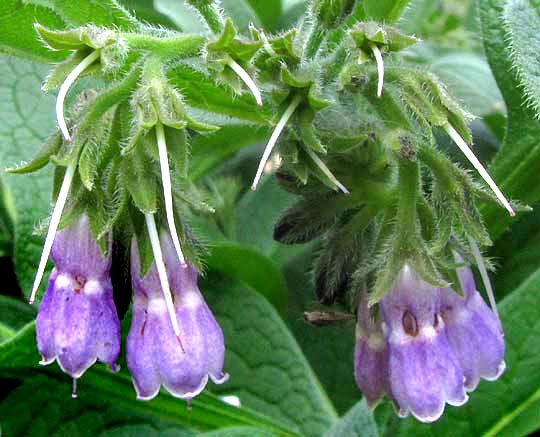Excerpts from Jim Conrad's
Naturalist Newsletter

from the the May 5, 2013 Newsletter issued from the Frio Canyon Nature Education Center in northern Uvalde County, southwestern Texas, on the southern border of the Edwards Plateau; elevation ~1750m (~5750 ft); N29.62°, W99.86°; USA
COMFREY FLOWERING
My neighbor Deborah is creating a fine garden populated with useful, pretty or otherwise interesting plants, and in one spot a dense, leafy, perennial herb about three feet tall
(1m) is at its peak of flowering. A small part is shown above. The large, simple leaves are soft and hairy, but it's the flowers that get your attention, their pale purple, bell-like corollas dangling from one-sided inflorescences that curve like scorpion tails. A flower close-up below:

The slender, pale items emerging from the calyxes at the top of the picture are styles exposed when corollas fell off. Styles are ovary necks at the tip of which reside tiny stigmas, which is were pollen grains germinate. The ovaries, which are the future fruits, are hidden within the hairy calyxes. Some corollas have holes in their sides. I think this is caused by "nectar robbers," where an insect such as a carpenter bee has torn through the corolla walls seeking a shortcut to the nectar, instead of entering through the narrow corolla mouths and navigating through stamens and scales to the nectar below.
This herb is Common Comfrey, SYMPHYTUM OFFICINALE, an Old World herb long honored as a powerful medicinal plant, and thus grown as a traditional garden herb throughout the ages. In everyday use among common folks it's been used for burns and minor cuts. Just mash some leaves to form a pulpy poultice and apply it to the injury. It's also been used to help bones knit and for sprains, torn ligaments, bruises, arthritis, bedsores, insect bites, nosebleeds, sunburn, and more.
"Comfrey tea" made by boiling leaves and roots for five minutes also has been prescribed for various internal ailments, but there's a controversy over whether the tea damages the liver or not. One website providing homeopathic remedies says that for "Pain in eye after a blow of an obtuse body," nothing is as good as a Comfrey tincture. One website sells a plastic tube containing 80 pellets of what it calls Symphytum officinale -- the technical name for Common Comfrey -- for $8.56, but it doesn't say what the pellets are good for, depending on "common knowledge," I suppose.
Last spring in the woods of southwestern Mississippi we found Wild Comfrey, Cynoglossum virginianum, which belongs to the same plant family, the Borage Family, or Boraginaceae, and whose leaves were similar but which produced very different flowers and fruits. You can compare Deborah's Common comfrey with a fruiting Wild Comfrey at http://www.backyardnature.net/n/12/120520cy.jpg.
Is Common Comfrey really a good medicine? On the one hand you have many generations of people who for centuries have used it and taught their children its virtues. On the other hand, the http://health-from-nature.net website claims that "Comfrey contains pyrrolizidine alkaloids that are highly toxic to the liver and can cause death. Internal use should be avoided. Toxic substances can also be absorbed through the skin, and harmful amounts may build up in the body. It should never be used on broken skin."
I suspect it's the usual situation: What's great medicine in small dosages, when overused, can be lethal.